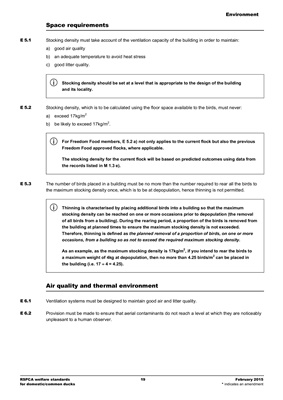
Environment
RSPCA welfare standards
for domestic/common ducks
19 February 2015
* indicates an amendment
Space requirements
E 5.1
Stocking density must take account of the ventilation capacity of the building in order to maintain:
a) good air quality
b) an adequate temperature to avoid heat stress
c) good litter quality.
Stocking density should be set at a level that is appropriate to the design of the building
and its locality.
E 5.2 Stocking density, which is to be calculated using the floor space available to the birds, must never:
a) exceed 17kg/m2
b) be likely to exceed 17kg/m2.
For Freedom Food members, E 5.2 a) not only applies to the current flock but also the previous
Freedom Food approved flocks, where applicable.
The stocking density for the current flock will be based on predicted outcomes using data from
the records listed in M 1.3 e).
E 5.3
The number of birds placed in a building must be no more than the number required to rear all the birds to
the maximum stocking density once, which is to be at depopulation, hence thinning is not permitted.
Thinning is characterised by placing additional birds into a building so that the maximum
stocking density can be reached on one or more occasions prior to depopulation (the removal
of all birds from a building). During the rearing period, a proportion of the birds is removed from
the building at planned times to ensure the maximum stocking density is not exceeded.
Therefore, thinning is defined as the planned removal of a proportion of birds, on one or more
occasions, from a building so as not to exceed the required maximum stocking density.
As an example, as the maximum stocking density is 17kg/m2, if you intend to rear the birds to
a maximum weight of 4kg at depopulation, then no more than 4.25 birds/m2 can be placed in
the building (i.e. 17 4 = 4.25).
Air quality and thermal environment
E 6.1 Ventilation systems must be designed to maintain good air and litter quality.
E 6.2 Provision must be made to ensure that aerial contaminants do not reach a level at which they are noticeably
unpleasant to a human observer.